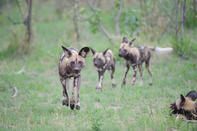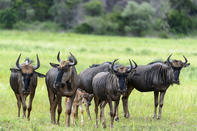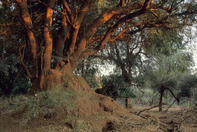Amazing African Wild Dog
The wild dog is not only on our top five most critically endangered list, but South Africa's most endangered predator. There are probably fewer than 520 of them in this country, and they are not faring much better elsewhere.

The thing is that you can't keep a good predator away from its prey. Unlike cheetahs, wild dogs will attack livestock where they can, for which they have been heavily persecuted.
They have also always been susceptible to lion attacks, and in modern times they have become exposed to diseases carried by domestic dogs. When it comes to hunting, size will often determine the strategy that a predator adopts. Wild dogs are relatively small, but because they hunt in family groups, they are perhaps the most proficient predators in Africa.
The Great African Antelopes

Royal Exodus

Much of the African open veld is characterised by termite-constructed earth mounds. Even in game-rich savanna areas, the biomass of termites — there are hundreds of species in Africa — exceeds that of all other animals. Soon after the first rains, winged princes and princesses, called alates, fly out from colonies, filling the air in a shimmering skein.
Survivors who are able to quickly mate and burrow become the queens and kings of new colonies, the rest are sought after as food for frogs, lizards, insectivorous mammals and birds, even the stately tawny, steppe and lesser spotted eagles… as well as humans. Apparently, they are best served fried in butter.
Worm Wanderlust
One of the most important forms of protein in the hotter regions of Southern Africa is the mopane worm: a fat, brightly coloured caterpillar of the moth Gonimbrasia belina.
At a certain time in early summer they swarm in their tens of millions over the mopane trees and then across the ground to burrow in the low-lying savanna region of the major valley areas. Syndicates of gatherers 'own' certain blocks of trees. A good place to witness this migration is in the Kruger National Park, on the H1 through road. Splat!
The Tallest Tale

 There is a wide variety of accommodation in Kruger National Park options ranging from rest camps to luxury Kruger Park safari lodges....
There is a wide variety of accommodation in Kruger National Park options ranging from rest camps to luxury Kruger Park safari lodges.... The Kruger National Park (KNP, or simply ‘Kruger’, for short) is the premier game reserve in South Africa. Offering excellent Big Five g...
The Kruger National Park (KNP, or simply ‘Kruger’, for short) is the premier game reserve in South Africa. Offering excellent Big Five g... Eager to keep the legend going, the Kruger National Park has launched the Emerging Tuskers Project ‘to identify all of the Park's large tu...
Eager to keep the legend going, the Kruger National Park has launched the Emerging Tuskers Project ‘to identify all of the Park's large tu...